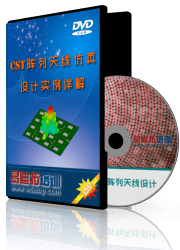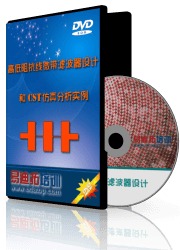- 易迪拓培训,专注于微波、射频、天线设计工程师的培养
feko characteristic mode
I need a "pure" (without accounting the excitation) [Z] matrix obtained by MoM simulator.
Is there any reliable 2.5 MoM simulator allowing to save the [Z] matrix into a file?
I appreciate if IE3D can in some advanced settings
Please don't reply with "code it by yourself", no time :)
Thanks!
eirp
Please display the Z(i,j) items on MODUA and select FILE->SAVE DISPLAYED DATA for a formated ASCII file. You can also select the FLOPPY icon on the vertical tool bar on the MODUA display to save the dispayed data into XML file format. The file is easy to understand. Also, you can import this file back to a different graph for overlaid display.
As I know, the Sonnet provides automatic de-embedding of the prot discontinuities and also export of data in spreadsheet, but you should play with output format.
As for 3D tools, WIPL-D provides de-embedding but you should create separate project describing the excitation in order to get the results.
Regards
D.
Hello jian and Debeli, thanks for reply.
Maybe I wasn't clear enough, my interest is the Z_mn MoM matrix in the equation:
[Z][J]=[E]
the equation is then solved for currents J
Thanks
eirp
To Eirp:
I am afraid there is no easy answer. Even if the code gives the moment matrix (Z_mn), you still need to find out how the unknowns are numbered.
Anyway, a number of tools can write the matrix into file(s):
1. EMPLAN (www.emanalysis.com), which is the code from a book. Follow the link to download a demo from the publisher Artech House. Handle horizontal currents on layered media, no vertical mesh capability.
2. For conductor in free space, maybe you can try some public domain MoM code.
3. Feko can write the matrix. Although it is written in binary format,
the structure is quite simple. Again, you need to spend some time playing with it.
4. Possibly IE3D, since it says external sovler can be used. so it must have written the matrix somewhere.
Since we have Jian's attention, can we ask:
what is the difference between "Z-Parameters" and "Z for S-Parameters"?
Thanks loucy for your valuable answer.
I'm familiar with IE3D, I still hope it's possible to extract it out.
I prefer reliable software which accuracy is proven.
(Eventually in worst case I can try FEKO)
Jian, please, can u give us your opinion?
Thanks!
eirp
I am sorry. I mis-understood the Z-matrix as the Z-parameters of the structure. Regarding the Z-matrix of the MOM, you can use the external matrix solver on the IE3D. It saves the whole matrix into a few temporary binary file. It is simple. However, it may not be completely documented. Interested users can contact zeland at support@zeland.com
Regarding the Z-matrix and Z for S-parameters, this is only defined on IE3D. Z-matrix is the origianl Z-matrix. However, some users want to see the Z'(i,j)=Z0*[1+S(i,j)]/[1-S(i,j)]. We define it as Z'(i,j) as Z for S-parameters. Many people may not realize that Z'(i,j) is different from Z(i,j) for multiple port structures even though they are identical for 1-port structures.
Hi, jian!
Yes, this is what I need (for "characteristic mode" study to be exact)
Unfortunately, ie3d crases with external matrix solver option even for very simple structure (during Solving Matrix process?)
Ports=1, Cells/Volumes/Unknowns=21/0/22, Uncertain RAM for External (0 MB for SMSi)
No.1/19 Freq = 0.5 (GHz): Cells/Volumes/Unknowns: 21/0/22, External: 52.27% Filling matrix: Solving Matrix...
Not regarding the crash, it created several files iox00904
Are they supposed to be the Zmn matrices?
Thanks for your attention for your topic!
BTW, do you plan to add feature "export MoM Zmn matrix in understable form"? I think I'm not the only one who appreciate this..
Kind regards
eirp
Hi, Erip: The feature is implemented a few versions before. It has never been tested in the recent versions because no user asks about it. We will try to test it again. I know we did have a limitation for at least 200 unknowns for it. I will check for it. Also, we can not write it in ASCII file format. It is too much bigger than the binary file format. The binary file format is quite simple too as long as you know the format. We will try to document it. Thanks!
Good news, thanks a lot, jian!
I'm referring to several papers which started to interest me concerning my research:
Harrington, Mautz: "Theory of characteristics modes for conducting bodies", IEEE Trans AP, vol. 19, pp.622-628, Sept. 1971
Austin, Murray: "The application of characteristics-mode technique to vehicle-mounted NVIS antennas", IEEE Trans AP, vol.40, no. 1, pp.7-21, Feb. 1998
...to name a few...
Binary format will not be problem :)
eirp
I agree with loucy in that it is straightforward to produce a [Z] matrix, but to use it, you must know the order of the unknowns, at least for majority of applications.
For MoM codes, the matrix is dense, so it is memory consuming.
I have done some tests with WIPL-D Pro with a built-in option of printing the [Z] matrix to an ASCII file. Also, I printed out vectors that show the order of unknowns in the system, nut this is something that engineers scarcely need to do.
That's why this option is not so usual in the commercially available codes.
Best regards,
drasko
I have the same problem, can someone write how I can do it
Thanks
In the book antenna modeling with Matlab, Z matrix is calculated with Matlab code. Perhaps that is interesting to this topic.
I see two kinds of definitions for impedance matrix: one considers the contribution from voltage excitation to surface current, the other considers the contribution from surface current to tangential electric field.
Do these definitions result in the same impedance matrix? I think this is very important, since the characteristic mode method concerns the latter definition.
Thanks!
CST微波工作室培训课程套装,专家讲解,视频教学,帮助您快速学习掌握CST设计应用
上一篇:研究电磁兼容问题是用FEKO吗?
下一篇:helphow to define a slotline feeding port in FEKO?











